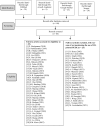Applications of 3D-Printed PEEK via Fused Filament Fabrication: A Systematic Review
- PMID: 34833346
- PMCID: PMC8619676
- DOI: 10.3390/polym13224046
Applications of 3D-Printed PEEK via Fused Filament Fabrication: A Systematic Review
Abstract
Polyether ether ketone (PEEK) is an organic polymer that has excellent mechanical, chemical properties and can be additively manufactured (3D-printed) with ease. The use of 3D-printed PEEK has been growing in many fields. This article systematically reviews the current status of 3D-printed PEEK that has been used in various areas, including medical, chemical, aerospace, and electronics. A search of the use of 3D-printed PEEK articles published until September 2021 in various fields was performed using various databases. After reviewing the articles, and those which matched the inclusion criteria set for this systematic review, we found that the printing of PEEK is mainly performed by fused filament fabrication (FFF) or fused deposition modeling (FDM) printers. Based on the results of this systematic review, it was concluded that PEEK is a versatile material, and 3D-printed PEEK is finding applications in numerous industries. However, most of the applications are still in the research phase. Still, given how the research on PEEK is progressing and its additive manufacturing, it will soon be commercialized for many applications in numerous industries.
Keywords: 3D printing; PEEK; additive manufacturing; aerospace; chemical; electrical; medical; polymer.
Conflict of interest statement
The authors declare no conflict of interest.
Figures





Similar articles
-
Influence of Layer Thickness and Raster Angle on the Mechanical Properties of 3D-Printed PEEK and a Comparative Mechanical Study between PEEK and ABS.Materials (Basel). 2015 Sep 1;8(9):5834-5846. doi: 10.3390/ma8095271. Materials (Basel). 2015. PMID: 28793537 Free PMC article.
-
Effects of printing path and material components on mechanical properties of 3D-printed polyether-ether-ketone/hydroxyapatite composites.J Mech Behav Biomed Mater. 2021 Jun;118:104475. doi: 10.1016/j.jmbbm.2021.104475. Epub 2021 Mar 20. J Mech Behav Biomed Mater. 2021. PMID: 33773239
-
Parameters Influencing the Outcome of Additive Manufacturing of Tiny Medical Devices Based on PEEK.Materials (Basel). 2020 Jan 18;13(2):466. doi: 10.3390/ma13020466. Materials (Basel). 2020. PMID: 31963725 Free PMC article. Review.
-
Fused Filament Fabrication of PEEK: A Review of Process-Structure-Property Relationships.Polymers (Basel). 2020 Jul 27;12(8):1665. doi: 10.3390/polym12081665. Polymers (Basel). 2020. PMID: 32726994 Free PMC article. Review.
-
Mechanical properties of fused filament fabricated PEEK for biomedical applications depending on additive manufacturing parameters.J Mech Behav Biomed Mater. 2021 Mar;115:104250. doi: 10.1016/j.jmbbm.2020.104250. Epub 2020 Dec 6. J Mech Behav Biomed Mater. 2021. PMID: 33302091
Cited by
-
Feasibility of 3D-Printed Locking Compression Plates with Polyether Ether Ketone (PEEK) in Tibial Comminuted Diaphyseal Fractures.Polymers (Basel). 2023 Jul 16;15(14):3057. doi: 10.3390/polym15143057. Polymers (Basel). 2023. PMID: 37514445 Free PMC article.
-
Low-Cost Cranioplasty-A Systematic Review of 3D Printing in Medicine.Materials (Basel). 2022 Jul 6;15(14):4731. doi: 10.3390/ma15144731. Materials (Basel). 2022. PMID: 35888198 Free PMC article. Review.
-
Structural and Dimensional Analysis by Computed Tomography of a Multi Geometric Template Manufactured by Fused Deposition Modeling.Micromachines (Basel). 2023 Oct 15;14(10):1934. doi: 10.3390/mi14101934. Micromachines (Basel). 2023. PMID: 37893371 Free PMC article.
-
Biomimetic Implant Surfaces and Their Role in Biological Integration-A Concise Review.Biomimetics (Basel). 2022 Jun 6;7(2):74. doi: 10.3390/biomimetics7020074. Biomimetics (Basel). 2022. PMID: 35735590 Free PMC article. Review.
-
Microscopic and Biomechanical Analysis of PEEK Interspinous Spacers for Spinal Fusion Applications.Materials (Basel). 2025 Feb 4;18(3):679. doi: 10.3390/ma18030679. Materials (Basel). 2025. PMID: 39942345 Free PMC article.
References
-
- Shekar R.I., Kotresh T.M., Rao P.M.D., Kumar K. Properties of high modulus PEEK yarns for aerospace applications. J. Appl. Polym. Sci. 2009;112:2497–2510. doi: 10.1002/app.29765. - DOI
-
- Mohiuddin M., Hoa S.V. Estimation of contact resistance and its effect on electrical conductivity of CNT/PEEK composites. Compos. Sci. Technol. 2013;79:42–48. doi: 10.1016/j.compscitech.2013.02.004. - DOI
-
- Liu Z., Wang L., Hou X., Wu J. Investigation on dielectrical and space charge characteristics of peek insulation used in aerospace high-voltage system. IEEJ Trans. Electr. Electron. Eng. 2020;15:172–178. doi: 10.1002/tee.23042. - DOI
Publication types
Grants and funding
LinkOut - more resources
Full Text Sources
Medical

